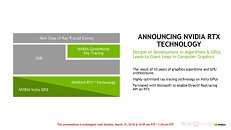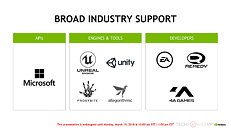Monday, March 19th 2018

Microsoft Releases DirectX Raytracing - NVIDIA Volta-based RTX Adds Real-Time Capability
Microsoft today announced an extension to its DirectX 12 API with DirectX Raytracing, which provides components designed to make real-time ray-tracing easier to implement, and uses Compute Shaders under the hood, for wide graphics card compatibility. NVIDIA feels that their "Volta" graphics architecture, has enough computational power on tap, to make real-time ray-tracing available to the masses. The company has hence collaborated with Microsoft to develop the NVIDIA RTX technology, as an interoperative part of the DirectX Raytracing (DXR) API, along with a few turnkey effects, which will be made available through the company's next-generation GameWorks SDK program, under GameWorks Ray Tracing, as a ray-tracing denoiser module for the API.
Real-time ray-tracing has for long been regarded as a silver-bullet to get lifelike lighting, reflections, and shadows right. Ray-tracing is already big in the real-estate industry, for showcasing photorealistic interactive renderings of property under development, but has stayed away from gaming, that tends to be more intense, with larger scenes, more objects, and rapid camera movements. Movies with big production budgets use pre-rendered ray-tracing farms to render each frame. Movies have, hence, used ray-traced visual-effects for years now, since it's not interactive content, and its studios are willing to spend vast amounts of time and money to painstakingly render each frame using hundreds of rays per pixel.Since using hundreds of rays per pixel at many frames per second is impractical from a performance standpoint, DXR will use many fewer rays per pixel and use clever tricks to optimize image quality. NVIDIA's RTX requires "Volta" (or later) GPUs, this technology won't wold on older architectures, not even "Pascal." From what we understand, the tensor cores in Volta are used to accelerate ray-tracing. Through a feature called "denoising", which uses fewer rays per pixel and fills in the remaining gaps using AI. Tensor cores can quickly train neural networks to reconstruct images, so real-time ray-tracing can be made possible. According to NVIDIA, RTX provides speedups of several hundred percent (ie, 2x, 3x faster) over the default DXR Compute Shader path.
DXR isn't NVIDIA-exclusive, even if NVIDIA made sure that the Microsoft DXR API is aware of RTX. NVIDIA has hence left it to Microsoft to support real-time ray tracing acceleration on older GPU architectures, presumably any architecture with DirectX 12 support.
NVIDIA RTX has two components - specialized hardware on the "Volta" GPU, and NVIDIA GameWorks Ray Tracing effects, that are standardized through DirectX Raytracing (DXR) API. NVIDIA "Volta" architecture is designed to support ray-tracing through a variety of interfaces, including DXR. Microsoft made DXR aware of NVIDIA's specialized hardware, which will accelerate GameWorks Ray Tracing effects, besides any proprietary effects that take advantage of DXR. It looks like RTX takes advantage of the tensor cores on "Volta" GPUs. These are specialized components NVIDIA originally designed to accelerate AI neural-net building and training. The company's Optix denoiser leverages AI, so we're sure that RTX relies on AI to get real-time ray-tracing accurate.Among the turnkey GameWorks effects are Area Shadows, Glossy Reflections, and Ambient Occlusion (the ray-traced version). Early access to select developers begins now, with general availability coming soon. Game engine developers such as Epic Games (Unreal Engine), Unity, EA-DICE Frostbite, and Allegorithmic have expressed interest in NVIDIA RTX, along with developers from EA's various studios, Remedy Entertainment, and 4A Games.
The press-release follows.
NVIDIA today announced NVIDIA RTX, a ray-tracing technology that brings real-time, cinematic-quality rendering to content creators and game developers. NVIDIA RTX is the product of 10 years of work in computer graphics algorithms and GPU architectures. It consists of a highly scalable ray-tracing technology running on NVIDIA Volta architecture GPUs. Architected to support ray tracing through a variety of interfaces, NVIDIA partnered closely with Microsoft to enable full RTX support for applications that use Microsoft's new DirectX Raytracing (DXR) API.
Long considered the definitive solution for realistic and lifelike lighting, reflections and shadows, ray tracing offers a level of realism far beyond what is possible using traditional rendering techniques. Real-time ray tracing replaces a majority of the techniques used today in standard rendering with realistic optical calculations that replicate the way light behaves in the real world, delivering more lifelike images.
"Real-time ray tracing has been a dream of the graphics industry and game developers for decades, and NVIDIA RTX is bringing it to life," said Tony Tamasi, senior vice president of content and technology at NVIDIA. "GPUs are only now becoming power enough to deliver real-time ray tracing for gaming applications, and will usher in a new era of next-generation visuals."
Ray tracing has been used for years to pre-render lifelike worlds in movies. But until now, it has been too computationally demanding to be practical for real-time, interactive gaming, which requires fast frame rates and low latency. NVIDIA RTX overcomes those limitations.
Broad Industry Support
"DirectX Raytracing is the latest example of Microsoft's commitment toward enabling developers to create incredible experiences using cutting-edge graphics innovations," said Max McMullen, development manager of Windows Graphics and AI at Microsoft. "Our close partnership with NVIDIA on DirectX Raytracing and NVIDIA's RTX technology brings real-time ray tracing closer than ever for millions of gamers on Windows."
Industry leaders such as 4A Games, Epic, Remedy Entertainment and Unity are featuring NVIDIA RTX in their technology demonstrations at this week's Game Developers Conference, in San Francisco. They are showing how real-time ray tracing can provide amazing, lifelike graphics in future games. And because RTX supports Microsoft DirectX Raytracing, the groundbreaking technology will be enjoyed by Windows users everywhere.
"The availability of NVIDIA RTX opens the door to make real-time ray tracing a reality," said Kim Libreri, chief technology officer at Epic Games. "By making such powerful technology available to the game development community with the support of the new DirectX Raytracing API, NVIDIA is the driving force behind the next generation of game and movie graphics."
"Integrating NVIDIA RTX into our Northlight engine was a relatively straightforward exercise," said Mikko Orrenmaa, technology team manager at Remedy Entertainment. "Developing exclusively on NVIDIA RTX, we were surprised just how quickly we were able to prototype new lighting, reflection and ambient occlusion techniques, with significantly better visual fidelity than traditional rasterization techniques. We are really excited about what we can achieve in the future with the NVIDIA RTX technology. Gamers are in for something special."
Introducing GameWorks for Ray Tracing
To allow game developers to take advantage of these new capabilities, NVIDIA also announced the NVIDIA GameWorks SDK will add a ray-tracing denoiser module. This suite of tools and resources for developers will dramatically increase realism and shorten product cycles in titles developed using the new Microsoft DXR API and NVIDIA RTX.
The upcoming GameWorks SDK - which will support Volta and future generation GPU architectures - enables ray-traced area shadows, ray-traces glossy reflections and ray-traced ambient occlusion.
With these capabilities, developers can create realistic, high-quality reflections that capture the scene around it and achieve physically accurate lighting and shadows. Making these capabilities available on an industry-standard platform like Microsoft DXR means every PC game developer will have access to levels of realism never before possible.
Real-time ray-tracing has for long been regarded as a silver-bullet to get lifelike lighting, reflections, and shadows right. Ray-tracing is already big in the real-estate industry, for showcasing photorealistic interactive renderings of property under development, but has stayed away from gaming, that tends to be more intense, with larger scenes, more objects, and rapid camera movements. Movies with big production budgets use pre-rendered ray-tracing farms to render each frame. Movies have, hence, used ray-traced visual-effects for years now, since it's not interactive content, and its studios are willing to spend vast amounts of time and money to painstakingly render each frame using hundreds of rays per pixel.Since using hundreds of rays per pixel at many frames per second is impractical from a performance standpoint, DXR will use many fewer rays per pixel and use clever tricks to optimize image quality. NVIDIA's RTX requires "Volta" (or later) GPUs, this technology won't wold on older architectures, not even "Pascal." From what we understand, the tensor cores in Volta are used to accelerate ray-tracing. Through a feature called "denoising", which uses fewer rays per pixel and fills in the remaining gaps using AI. Tensor cores can quickly train neural networks to reconstruct images, so real-time ray-tracing can be made possible. According to NVIDIA, RTX provides speedups of several hundred percent (ie, 2x, 3x faster) over the default DXR Compute Shader path.
DXR isn't NVIDIA-exclusive, even if NVIDIA made sure that the Microsoft DXR API is aware of RTX. NVIDIA has hence left it to Microsoft to support real-time ray tracing acceleration on older GPU architectures, presumably any architecture with DirectX 12 support.
NVIDIA RTX has two components - specialized hardware on the "Volta" GPU, and NVIDIA GameWorks Ray Tracing effects, that are standardized through DirectX Raytracing (DXR) API. NVIDIA "Volta" architecture is designed to support ray-tracing through a variety of interfaces, including DXR. Microsoft made DXR aware of NVIDIA's specialized hardware, which will accelerate GameWorks Ray Tracing effects, besides any proprietary effects that take advantage of DXR. It looks like RTX takes advantage of the tensor cores on "Volta" GPUs. These are specialized components NVIDIA originally designed to accelerate AI neural-net building and training. The company's Optix denoiser leverages AI, so we're sure that RTX relies on AI to get real-time ray-tracing accurate.Among the turnkey GameWorks effects are Area Shadows, Glossy Reflections, and Ambient Occlusion (the ray-traced version). Early access to select developers begins now, with general availability coming soon. Game engine developers such as Epic Games (Unreal Engine), Unity, EA-DICE Frostbite, and Allegorithmic have expressed interest in NVIDIA RTX, along with developers from EA's various studios, Remedy Entertainment, and 4A Games.
The press-release follows.
NVIDIA today announced NVIDIA RTX, a ray-tracing technology that brings real-time, cinematic-quality rendering to content creators and game developers. NVIDIA RTX is the product of 10 years of work in computer graphics algorithms and GPU architectures. It consists of a highly scalable ray-tracing technology running on NVIDIA Volta architecture GPUs. Architected to support ray tracing through a variety of interfaces, NVIDIA partnered closely with Microsoft to enable full RTX support for applications that use Microsoft's new DirectX Raytracing (DXR) API.
Long considered the definitive solution for realistic and lifelike lighting, reflections and shadows, ray tracing offers a level of realism far beyond what is possible using traditional rendering techniques. Real-time ray tracing replaces a majority of the techniques used today in standard rendering with realistic optical calculations that replicate the way light behaves in the real world, delivering more lifelike images.
"Real-time ray tracing has been a dream of the graphics industry and game developers for decades, and NVIDIA RTX is bringing it to life," said Tony Tamasi, senior vice president of content and technology at NVIDIA. "GPUs are only now becoming power enough to deliver real-time ray tracing for gaming applications, and will usher in a new era of next-generation visuals."
Ray tracing has been used for years to pre-render lifelike worlds in movies. But until now, it has been too computationally demanding to be practical for real-time, interactive gaming, which requires fast frame rates and low latency. NVIDIA RTX overcomes those limitations.
Broad Industry Support
"DirectX Raytracing is the latest example of Microsoft's commitment toward enabling developers to create incredible experiences using cutting-edge graphics innovations," said Max McMullen, development manager of Windows Graphics and AI at Microsoft. "Our close partnership with NVIDIA on DirectX Raytracing and NVIDIA's RTX technology brings real-time ray tracing closer than ever for millions of gamers on Windows."
Industry leaders such as 4A Games, Epic, Remedy Entertainment and Unity are featuring NVIDIA RTX in their technology demonstrations at this week's Game Developers Conference, in San Francisco. They are showing how real-time ray tracing can provide amazing, lifelike graphics in future games. And because RTX supports Microsoft DirectX Raytracing, the groundbreaking technology will be enjoyed by Windows users everywhere.
"The availability of NVIDIA RTX opens the door to make real-time ray tracing a reality," said Kim Libreri, chief technology officer at Epic Games. "By making such powerful technology available to the game development community with the support of the new DirectX Raytracing API, NVIDIA is the driving force behind the next generation of game and movie graphics."
"Integrating NVIDIA RTX into our Northlight engine was a relatively straightforward exercise," said Mikko Orrenmaa, technology team manager at Remedy Entertainment. "Developing exclusively on NVIDIA RTX, we were surprised just how quickly we were able to prototype new lighting, reflection and ambient occlusion techniques, with significantly better visual fidelity than traditional rasterization techniques. We are really excited about what we can achieve in the future with the NVIDIA RTX technology. Gamers are in for something special."
Introducing GameWorks for Ray Tracing
To allow game developers to take advantage of these new capabilities, NVIDIA also announced the NVIDIA GameWorks SDK will add a ray-tracing denoiser module. This suite of tools and resources for developers will dramatically increase realism and shorten product cycles in titles developed using the new Microsoft DXR API and NVIDIA RTX.
The upcoming GameWorks SDK - which will support Volta and future generation GPU architectures - enables ray-traced area shadows, ray-traces glossy reflections and ray-traced ambient occlusion.
With these capabilities, developers can create realistic, high-quality reflections that capture the scene around it and achieve physically accurate lighting and shadows. Making these capabilities available on an industry-standard platform like Microsoft DXR means every PC game developer will have access to levels of realism never before possible.






39 Comments on Microsoft Releases DirectX Raytracing - NVIDIA Volta-based RTX Adds Real-Time Capability
Also, wait, Allegorithmic are "game engine" devs?
I know they make material editors and texturing tools, but an entire engine?Please tell me that use of words was unintended...
:roll:
Update from Hexus:
hexus.net/tech/news/graphics/116354-amd-nvidia-working-closely-microsoft-dxr-api/
en.wikipedia.org/wiki/Global_illumination
Inb4 the resurrection of 1080p
Are there any videos, how this work ?
Microsoft so far has only verified NVidia's project , so AMD's statement can be considered a little , ehmm.... " premature ":rolleyes: ....at best !!! (*hype at worst !!)
On the other hand I wonder what Imtec stand on this is. They have had special hw for ray tracing on their power GR6500 gpu since 2016. Is it compatible with DXR or not.
So much news was written about Nvidia skipping Volta like it was a sure thing.
But man Nvidia was already a must have because of cuda in this area, and now this...open cl get no love at all, even on osx the dev would rather work with metal.
The bad news is Vulkan, the open and cross-platfom alternative is once again lagging behind.
OTOY also collaborated for hardware RT with Imagination Technologies PowerVR Wizard GPUs, just before Apple dropped them as a supplier and they got sold.